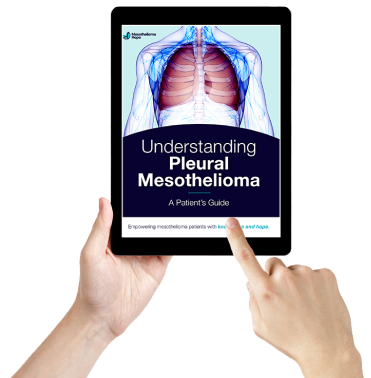What Is Pleurodesis Surgery for Mesothelioma?
Pleurodesis for mesothelioma is a surgical procedure that can help patients who suffer from malignant (cancerous) pleural effusions.
Pleural effusions occur in over 90% of malignant pleural mesothelioma patients, according to a 2022 report in the American Journal of Medicine. They cause shortness of breath, pain, and other symptoms.
To perform a mesothelioma pleurodesis, a doctor drains the pleural fluid from the lining of the lungs (pleura). They then irritate the pleural space. There are two layers of the pleura, and a pleurodesis causes them to stick together. This way, the effusions won’t come back.
Top pleural mesothelioma doctors can perform a pleurodesis and other surgeries. Get help finding specialists with our Free Mesothelioma Doctor Match.
Who Can Benefit From a Pleurodesis for Mesothelioma?
Mesothelioma patients suffering from pleural effusions — particularly ones that won’t go away — are generally good candidates for pleurodesis.
Pleurodesis can ease pleural effusion symptoms like:
- Breathing difficulties
- Chest pain
- Coughing
Doctors can also use a pleurodesis to treat pneumothorax (collapsed lung). By getting a pleurodesis for pneumothorax, the lung lining will be sealed, so air can’t collect inside.

Watch this short video to learn how doctors perform a pleurodesis and how it may help you if you have pleural mesothelioma. View Transcript.
Duration: 0 min 56 sec
Are you or a loved one suffering from painful fluid buildup caused by pleural mesothelioma? You may be able to find relief with a surgical procedure known as pleurodesis.
Mesothelioma pleurodesis is a minor surgery designed to treat pleural effusions. These effusions occur when fluid builds up between the lung and the chest wall, causing symptoms like shortness of breath, chest pain, and difficulty breathing.
During a pleurodesis, a skilled surgeon drains the extra fluid and permanently seals the lung lining to prevent fluid from building up again in the future.
Patients who undergo pleurodesis experience improved quality of life, reduced chest pain, and enhanced breathing ability.
If you or a loved one are seeking relief from pleural effusions caused by mesothelioma, pleurodesis may offer a permanent solution.
Contact our Patient Advocates today to see if you’re a candidate for pleurodesis and connect with local surgeons who can help.
Mesothelioma Pleurodesis vs. Other Treatments
Pleurodesis can be more effective in easing pleural mesothelioma symptoms than another commonly used treatment called a thoracentesis.
While a thoracentesis can be used to drain pleural effusions, it can’t prevent them from coming back.
Further, a pleurodesis may be a good alternative if you don’t wish to get an indwelling pleural catheter. Doctors often recommend catheters to treat recurring pleural effusions, but this requires having a tube inserted in your chest.


“Ask your oncologist their thoughts about a talc pleurodesis. This could prevent you from having a pleural catheter.”
Finally, it’s important to know that pleurodesis is a palliative treatment. Its main purpose is to improve quality of life. If patients want to live longer, they’ll need to undergo aggressive treatments.
For example, early-stage mesothelioma patients can undergo a major surgery called a pleurectomy with decortication (P/D). The lung lining and all tumors inside are removed, helping to improve the patient’s overall survival. Doctors can perform a pleurodesis during this procedure too.
Types of Mesothelioma Pleurodesis
There are two main types of pleurodesis: chemical and mechanical. Doctors can see which is the best option for a pleural mesothelioma patient when assessing their health care needs.
Chemical Pleurodesis
A chemical pleurodesis treats malignant pleural effusions by injecting what’s known as a sclerosing agent into the pleural cavity. The agent is a chemical that irritates the lung lining.
Chemicals that may be used include:
- Cisplatin (a chemotherapy drug)
- Doxycycline
- Talc slurry (talcum powder and saline mix)
Oncology (cancer) doctors first drain the pleural effusion before administering the sclerosing agent through a chest tube. The pleural layers will then get stuck together.
A chemical pleurodesis is considered a “definitive intervention” for pleural effusions, according to a 2022 American Journal of Medicine report.
Mechanical Pleurodesis
Also known as a dry abrasion, this treatment allows mesothelioma doctors to irritate the pleura themselves rather than using a chemical.
After draining the pleural fluid buildup, the doctor performs surgery to disrupt the pleura, causing inflammation and scarring. This fuses the layers of the pleura together.
Doctors often use video-assisted thoracoscopic surgery (VATS) to perform a mechanical pleurodesis. This thoracoscopic pleurodesis is done by feeding a tube with a camera at the end into the pleura and then causing irritation.
An article in the medical journal Respiratory Research notes that mechanical pleurodesis is less commonly used than chemical pleurodesis, as it’s a more involved surgery.
Other Options
Besides a chemical or mechanical pleurodesis, doctors can sometimes use other methods to seal the pleura. For example, a 2022 report in Seminars in Interventional Radiology notes that lasers or argon beams can be used as a form of pleurodesis.
If a patient is unable or unwilling to undergo a pleurodesis, doctors may recommend a pleural catheter so the patient will be able to drain the fluid without the need for repeated hospital stays.
Learn more about all the treatment options available to you in our Free Pleural Mesothelioma Guide.
Steps for Getting a Pleurodesis for Mesothelioma
Below are the key steps involved in getting a pleurodesis for mesothelioma.
1. Schedule a Consultation
If a patient is suffering from a pleural effusion, they can reach out to their doctor to get a consultation about a mesothelioma pleurodesis.
During this appointment, the doctor will tell the patient how a pleurodesis works and see if the procedure is right for them.
2. Prepare for Pleurodesis
If doctors believe that a mesothelioma pleurodesis can help a patient, they’ll offer guidelines to prepare for the procedure.
Patients may need to not eat or drink for several hours beforehand. They should also tell doctors about any medications before agreeing to get a pleurodesis, as some (like blood thinners) could affect the procedure.
3. Undergo Pleurodesis
A pleurodesis procedure is a multi-step process.
These steps include:
- Apply local anesthetic: The doctor will give the patient a small injection of local anesthetic to ensure the process is as pain-free as possible.
- Attach a chest drain: The patient may need to have their pleural effusion drained before undergoing a pleurodesis. In this case, the surgeon will put a needle into the patient’s chest wall and attach it to a drain. It typically takes a few days for all the excess fluid to be drained out, according to Roswell Park Comprehensive Cancer Center.
- Start the surgery: After all the fluid has been drained, doctors can then make a surgical incision, which is needed so they can reach the pleura.
- Irritate the pleura: The surgeon will either chemically or mechanically cause irritation within the pleural space so the fluid doesn’t build up again.
Contact our team now for help getting a mesothelioma pleurodesis and other top treatments.
4. Pleurodesis Recovery
After the pleurodesis, the doctor will seal the incision site so the patient can start to heal.
Patients typically need to spend 2 nights in the hospital following a pleurodesis so doctors can make sure they’re recovering properly.
Once discharged, the patient can care for themselves by:
- Avoiding quick movements or lifting heavy objects until they feel better
- Calling their doctor if possible complications appear (fever, infection, etc.)
- Resting when they feel tired
- Taking doctor-prescribed pain medicine
Patients can also schedule a follow-up visit with their doctor as needed.
Pleurodesis Side Effects and Risks
Like any medical procedure, getting a mesothelioma pleurodesis has some side effects and risks.
Pleurodesis complications can include:
- Breathing difficulties
- Chest tightness due to inflammation
- Fever
- Infection
- Pain
Many of these symptoms (such as breathlessness and fever) are usually minor and go away within a few days.
Find Doctors for Mesothelioma Pleurodesis
If you or a loved one has recurrent pleural effusions and are interested in getting a pleurodesis, reach out to Mesothelioma Hope today.
Our team can connect you with personalized medical guidance, financial assistance, and supportive care right now.
Call (866) 608-8933 or use our Free Doctor Match to connect with top mesothelioma specialists near you.
Mesothelioma Pleurodesis FAQs
How long does a pleurodesis last?
A pleurodesis procedure takes about 1.5 hours, but preparing for it and recovering from it may take a bit longer.
How long your pleurodesis will take depends on unique factors in your case. For example, if you need to have fluid drained from your body before the pleurodesis occurs, this can add several more days to the procedure.
What is the life expectancy after pleurodesis?
Mount Sinai Health System researchers looked at the survival rates and average life expectancies after pleurodesis for patients with malignant pleural effusion.
Those who received a mesothelioma talc pleurodesis lived 14 months on average, and the 2-year survival rate ranged from 10%-13%.
Is pleurodesis major surgery?
No, mesothelioma pleurodesis is a minimally invasive surgery for pleural mesothelioma. This means it’s not as aggressive compared to other surgeries used to help patients live longer, like a pleurectomy with decortication.
However, as with any surgery, there are always risks. Your mesothelioma doctor will discuss any possible risks ahead of time and do everything they can to avoid them.
How long do you stay in the hospital after pleurodesis?
Most patients will need to stay in the hospital for 2 days to recover from pleurodesis. During this time, they’ll be monitored to make sure they recover properly.
Doctors can provide a better timeline as to when the patient will be fully recovered after they’re dismissed, as it can vary with each case. It shouldn’t take long for the patient to completely recover from a pleurodesis and feel better.
What are the long-term effects of pleurodesis?
After a mesothelioma pleurodesis, you should find relief as fluid won’t build up around your lungs anymore. Associated symptoms like shortness of breath and chest pain should lessen or disappear as a result.
If these symptoms return after you’ve had a mesothelioma pleurodesis, contact your doctor immediately.






